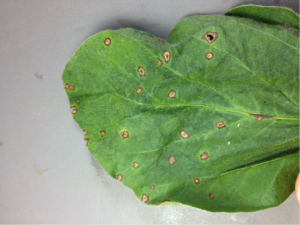
Fact Sheets And Publications

Frogeye Leaf Spot on Soybean
October 2025 | Written by: Nathan Kleczewski Ph.D., Extension Plant Pathologist, Reviewed by: Dr. Alyssa Betts
Frogeye leaf spot (FLS), caused by Cercospora sojina, is a serious disease affecting soybeans and can cause more than 30% yield loss if not properly managed. First reported in the United States in 1924, FLS was largely a problem for southern states until recently. Over the past 10 years the disease has been reported throughout soybean growing regions of the United States as far north as Minnesota [1]. FLS occurs in Delaware but to date its effects have not been severe. This publication will discuss symptoms of the disease, the disease cycle, and management recommendations.

Disease Identification
Symptoms of Frogeye leaf spot often occur after flowering, but can occur at any stage of growth under the appropriate environmental conditions. C. sojina produces tan/brown, elliptical lesions with a brown to purple boarder (Figure 1). Under humid conditions, long, silvery conidiophores emerging from black dots can be viewed on the underside of leaves with the aid of a 10x hand lens. Diseased plants may have a layered appearance because symptoms tend to be more severe on young leaves vs mature foliage (Figure 2). Under severe disease pressure lesions may coalesce and cause leaf drop. C. sojina may infect stems, causing dark red to brown lesions that are easily confused with other diseases of soybean. On pods, C. sojina causes circular to oblong, reddish, sunken lesions. Infected seeds may be discolored, often dark brown or red. This is one way that frogeye leaf spot differs from purple seed stain caused by the related fungus, Cercospora kikuchii.

Disease Cycle
Primary infections by C. sojina originate from infested soybean residue or seed. The fungus produces spores under warm, humid conditions with heavy dews (77-86⁰F; >90% RH). Spores are spread to new plants by wind and rain where they infect foliage. Symptoms are produced within 14 days after infection [1]. Unlike brown spot, Frogeye leaf spot causes more disease on younger foliage than older foliage at the base of plants. Under appropriate conditions the fungus will continue to produce spores, which increases disease severity. Disease spread is short, unlike other diseases of soybean such as soybean rust. Mild winter temperatures and conservation tillage favor pathogen survival [2].
Management
Management of Frogeye leaf spot is achieved by using resistant varieties, planting disease free seed, and managing residue. Under extreme conditions the use of a fungicide may be warranted. These practices will reduce the amount of spores available to infect plants and the level of disease in a given year.
Resistant Varieties
Soybean varieties with resistance to Frogeye leaf spot are available. Information on varietal resistance to Frogeye leaf spot can be obtained from the seed company or your local seed supplier.
Disease-free Seed
Use only clean, disease-free seed. Although the role of seed-borne inoculum in epidemics of Frogeye leaf spot is not clear, it has the potential to serve as a means to infect fields with the fungus.
Promote Residue Decomposition
In Delaware deep tillage may not be an option as many growers use no-till or minimal tillage systems. In these situations, practices that remove soybean residue or promote residue decomposition will help reduce inoculum levels. Such practices include chopping or shredding residue or disking after harvest.
Chemical control
When disease is severe, within season management of Frogeye leaf spot can be achieved through well timed fungicide applications. Research from other multiple states indicates that applications made between R2 and R5 are the most economical for control of the disease. In general, if foliar disease is present at significant levels at R2 and environmental conditions are favorable, a spray may be warranted. Fungicide applications to manage Frogeye leafspot are rarely warranted in Delaware.
Fungicide Resistance Issues
Fungicides belonging to group 3 (DMI-triazole) and group 11 (QoI-strobilurins) classes are most often used to control Frogeye leaf spot. However, it is important to note that resistance of C. sojina to group 11 fungicides has been reported in Arkansas, Kentucky, Illinois, Tennessee, and Missouri [3, 4]. Resistance develops when continued applications of a given fungicide class over time selects for pathogens that are resistant or less sensitive to the fungicide active ingredient. Over time these individuals reproduce and make up the majority of the pathogen population, resulting in a reduction in fungicide efficacy. Group 11 fungicides are, “all or nothing” fungicides; therefore, resistant individuals are unaffected by the fungicide active ingredient. To minimize the chance for resistance development, group 11 fungicides should be tank mixed with other fungicides that belong to a different fungicide group and are labeled for Frogeye leaf spot or rotated with other fungicides of different groups if multiple fungicide applications are used during the growing season.
References
- Mian, M.A.R., et al., Frogeye leaf spot of soybean: A review and proposed race designations for isolates of Cercospora sojina Hara. Crop Science, 2008. 48(1): p. 14-24.
- Cruz, C.D. and A.E. Dorrance, Characterization and survival of Cercospora sojina in Ohio. Online. Plant Health Progress, 2009. doi:10.1094/PHP-2009-0512-03-RS.
- Zhang, G.R., et al., Sensitivity of Cercospora sojina isolates to quinone outside inhibitor fungicides. Crop Protection, 2012. 40: p. 63-68.
- Zhang, G.R., M.A. Newman, and C.A. Bradley, First report of the soybean Frogeye leaf spot fungus (Cercospora sojina) resistant to quinone outside inhibitor fungicides in North America. Plant Disease, 2012. 96(5): p. 767-767.
Date Published: 02/2014
Reviewed: 10/15/2025
Author(s): Nathan Kleczewski Ph.D.
Extension Plant Pathologist
UD Cooperative Extension
This institution is an equal opportunity provider.
In accordance with Federal law and U.S. Department of Agriculture policy, Cooperative Extension is prohibited from discriminating on the basis of race, color, national origin, sex, age, or disability.
